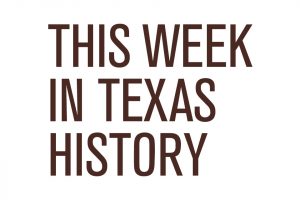By Bartee Haile
While on patrol off the Mexican coast on March 20, 1836, the Invincible vanquished an enemy man-of-war and seized an American blockade runner on the high seas.
It was all in a day’s work for the Texas Navy.
During the darkest hour of the Lone Star Revolution, Jeremiah Brown put to sea in a converted slave smuggling schooner. As captain of the Invincible, his mission in the aftermath of the Alamo massacre was to keep Mexican vessels bottled up in port and to stop third countries from supplying Santa Anna with war materiel.
A month before the Battle of San Jacinto, a merchant ship brimming with military hardware slipped out of Matamoros harbor. To ensure that the freighter rendezvoused with ground forces in Texas, the man-of-war Bravo provided an armed escort.
The two-ship convoy made a desperate dash for open water, but the Invincible was waiting. The Mexican warship accepted the challenge, and for the next hour the adversaries traded broadsides with the Bravo getting the worst of it.
From out of nowhere, a double-masted intruder of unknown allegiance appeared on the horizon. Taking advantage of the lull in the fighting, the Bravo limped away while the Invincible headed straight for the mystery ship.
To the Texans’ surprise, the party crasher was flying the Stars and Stripes. Spared a second round of combat, Capt. Brown leisurely pulled alongside the brig bearing the name Pocket. But the refusal of the American skipper to comply with a routine request for destination and papers instantly put Brown back on his guard.
The Texans stormed aboard and took control of the Pocket at gunpoint. The sight of cocked pistols convinced the uncooperative captain to hand over the manifest, which showed he carried harmless consumer goods bound for Matamoros. But why the initial defiance and what was the U.S. Navy doing on a commercial cruise?
Although the very idea of American seamen in league with Mexicans was unthinkable, Capt. Brown decided to inspect the hold. He could not believe his eyes. The Pocket was packed with contraband – guns, powder, ammunition, everything dictator Santa Anna needed to finish off the retreating rebels.
The ship was searched from stem to stern, and moments later a loud commotion below deck signaled another shocking discovery. Into the bright sunlight, the Texas sailors dragged four Americans caught red-handed with commissions in the Mexican Navy.
One of the quaking-in-their-books quartet needed no introduction. Capt. Brown, as well as most Anglo colonists, would have known the hated Thomas Thompson anywhere.
While serving as a Mexican naval officer in the summer of 1835, the Englishman ordered the inhabitants of Anahuac to disband their militia. Infuriated by their refusal, Thompson threatened to torch the town.
Two months after the Anahuac incident, the Texans took their revenge. In retaliation for the unwarranted capture of a private boat, they opened fire on the Brit wounding him in both legs. He was taken to New Orleans and formally accused of piracy.
By the time the case came to court in early 1836, the Texas Revolution was in full swing. The trial degenerated into a shameful circus, as the presiding judge shied away from the political implications of the proceedings and opposing counsels threw books and inkwells at each other. In the end, the Louisiana magistrate turned the defendant loose but jailed the lawyers.
Clapping Thompson and the three American turncoats in irons, Capt. Brown sailed the Pocket to Galveston. Leaving the fate of the prisoners and their ship in the hands of his superiors, he went onto New Orleans for provisions and repairs.
Worked up by a prejudiced press, the usually sympathetic citizens of the Crescent City greeted the Invincible with hostility. Fearing a mob attack, the Texans raced back to ship but hardly cleared the mouth of the Mississippi before being overtaken by a naval cutter.
Detained as pirates, the captain and crew of the Invincible were freed by a local judge, who defied public opinion by tossing the preposterous case out of court. On their second try, the lucky Lone Star sailors made good their escape from New Orleans.
The rebel regime in Texas soon released the Pocket prisoners and purchased the ship, a generous gesture not required by international law. Under the circumstances, Washington should have been more than satisfied, especially since running guns to Santa Anna contradicted official U.S. policy.
But the American government chose to make an issue out of the Pocket affair and demanded compensation for the “victims.” After at first refusing to pay a penny in damages, President Sam Houston authorized a settlement of $12,455 in March 1838 to improve the chances of early annexation.
When the Potomac politicians would not give Texas the time of day a few months later, Houston probably wished he had stopped payment on the check.
Don’t have a copy of “Texas Boomtowns: A History of Blood and Oil”? Order Bartee’s latest book today with a check for $28.80 to Bartee Haile, P.O. Box 152, Friendswood, TX 77549 or on-line at barteehaile.com






